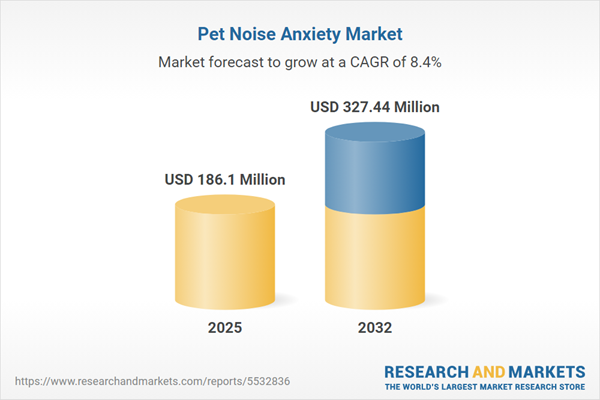Speak directly to the analyst to clarify any post sales queries you may have.
The pet noise anxiety market is evolving rapidly, driven by innovation in animal care, regulatory transitions, and demand for integrated solutions. Senior leaders require clear, actionable intelligence to guide investments, manage risk, and align with shifting expectations in this specialty segment.
Market Snapshot: Pet Noise Anxiety Market Size and Growth
The global pet noise anxiety market continues on a strong growth trajectory, shaped by increased investment in specialized treatments and heightened awareness among pet owners. As of 2024, the total market value stands at USD 171.63 million, projected to reach USD 186.10 million by 2025 and USD 327.44 million by 2032, representing a compound annual growth rate (CAGR) of 8.40%. This expansion is propelled by advances in behavioral therapies, adoption of digital care models, and diversified distribution platforms that align with changing consumer demands and clinical best practices. Stakeholders are leveraging digital technology, evidence-based interventions, and a global shift toward animal wellness to accelerate market development.
Scope & Segmentation of the Pet Noise Anxiety Market
Defining the pet noise anxiety market’s key segments enables targeted strategies, informed investments, and differentiated product development. Clear segmentation is critical for senior executives seeking to optimize resource allocation and anticipate client requirements in diverse environments.
- Animal Types: Market solutions are specifically tailored for dogs, cats, and horses, addressing varying anxiety triggers and supporting improved clinical outcomes.
- Product Types: Key offerings include anxiety sprays, calming collars, audio therapy devices, and dietary supplements, which target both behavioral and physical symptoms of pet noise anxiety.
- Distribution Channels: Products are available through mass retailers, digital platforms, specialty pet outlets, and veterinary clinics, strengthening access and supporting both consumer and veterinary purchase trends.
- Therapeutic Agents: The portfolio spans natural remedies such as herbal extracts and amino acids, in addition to synthetic solutions like pheromones and pharmaceuticals, reflecting a spectrum of professional protocols and owner preferences.
- Geographic Regions: Strategic approaches are developed for the Americas, Europe, Middle East & Africa, and Asia-Pacific, incorporating local regulations and regional attitudes toward pet anxiety management.
- Key Companies: Leading industry players include Mars, Incorporated; Nestlé Purina PetCare Company; Ceva Santé Animale S.A.; Vetoquinol S.A.; Elanco Animal Health Incorporated; Zoetis Inc.; Hill’s Pet Nutrition, Inc.; Thriving Pets, Inc.; Pet Remedy Limited; and SmartPetLove, Inc. These organizations set performance standards and foster continuous industry advancements.
This segmentation underpins targeted technology deployment, efficient logistics, and adaptive business strategies, enabling organizations to meet diverse regulatory standards and the varied expectations of customers and veterinary professionals internationally.
Key Takeaways for Senior Decision-Makers
- A holistic market approach integrates behavioral, digital, and pharmaceutical solutions, answering demand for comprehensive pet anxiety care across consumer and clinical settings.
- Collaboration between technology providers and animal behavior experts is accelerating the development of personalized therapies and scalable digital service models.
- Adapting to regional regulatory standards and cultural perceptions facilitates trusted partnerships between veterinarians and pet owners and drives greater market penetration.
- Expanding digital distribution not only broadens access to pet noise anxiety products but also enhances ongoing client education, supporting lasting engagement.
- Strategic alliances across veterinary, animal health, and technology sectors are shortening time-to-market for advanced therapeutic interventions and seamlessly integrating new solutions into existing care networks.
Tariff Impact on the Pet Noise Anxiety Market
Adjustments in U.S. tariffs have affected the availability of certain botanical ingredients commonly used in anxiety products, prompting companies to expand supplier bases and increase local procurement. These measures are reinforcing supply chain stability and securing continuous delivery in the face of fluctuating trade conditions.
Methodology & Data Sources
This market analysis is grounded in rigorous secondary research, regular review of evolving regulatory frameworks, and targeted interviews with veterinarians, industry specialists, and end users. Segmentation-based approaches ensure the insights remain relevant and actionable within a rapidly changing business landscape.
Why This Report Matters
- Equips senior leaders with the intelligence necessary to drive segment-specific strategies and unlock new growth opportunities in the pet noise anxiety sector.
- Clarifies the intersection of regulatory evolution and technology adoption, supporting timely adaptation to complex market demands and operational compliance.
- Enables more effective supply chain and product decisions by providing actionable, up-to-date analysis aligned with global market dynamics.
Conclusion
Sustained leadership in the pet noise anxiety market hinges on agile strategy, advanced technology integration, and proactive regulatory alignment, ensuring organizations stay competitive as industry conditions progress.
Additional Product Information:
- Purchase of this report includes 1 year online access with quarterly updates.
- This report can be updated on request. Please contact our Customer Experience team using the Ask a Question widget on our website.
Table of Contents
3. Executive Summary
4. Market Overview
7. Cumulative Impact of Artificial Intelligence 2025
Companies Mentioned
The companies profiled in this Pet Noise Anxiety market report include:- Mars, Incorporated
- Nestlé Purina PetCare Company
- Ceva Santé Animale S.A.
- Vetoquinol S.A.
- Elanco Animal Health Incorporated
- Zoetis Inc.
- Hill’s Pet Nutrition, Inc.
- Thriving Pets, Inc.
- Pet Remedy Limited
- SmartPetLove, Inc.
Table Information
| Report Attribute | Details |
|---|---|
| No. of Pages | 181 |
| Published | October 2025 |
| Forecast Period | 2025 - 2032 |
| Estimated Market Value ( USD | $ 186.1 Million |
| Forecasted Market Value ( USD | $ 327.44 Million |
| Compound Annual Growth Rate | 8.4% |
| Regions Covered | Global |
| No. of Companies Mentioned | 11 |









